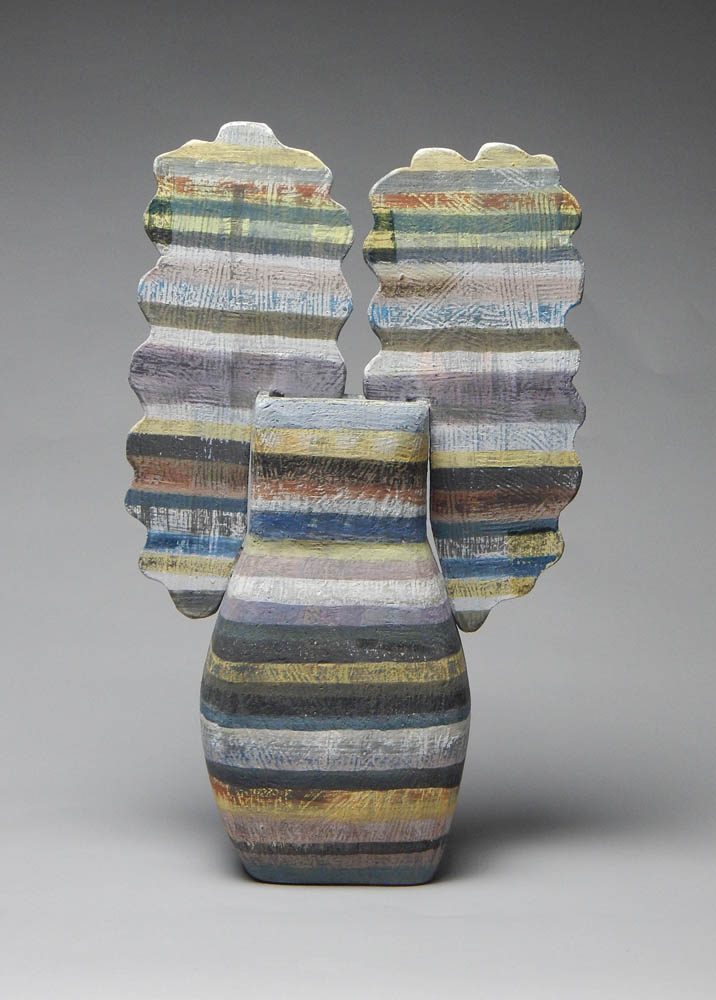in conversation: Matthew Sharpe and Sue Havens
I first encountered Sue Havens’s work in 2002. She was not yet a ceramicist, but her aesthetic restlessness and omnivorous interest in human-made objects of all kinds—buildings and architectural details, cracked sidewalks, furniture, hats and dresses, toys, logos and signage—was already abundant, both in the not-quite-two-dimensional canvases and other objects she made, and in how she painted them. Havens grew up in Rochester, New York, came to New York City for college at Cooper Union, and received her MFA in painting from Bard College. During the 25 years she lived in New York, she worked as a prototype painter for the Danbury Mint and as a touch-up artist at Madame Tussaud’s Wax Museum (“I painted Picasso!”). She also wrote and illustrated the book Make Your Own Toys. She now teaches at University of South Florida in Tampa.
Havens told me that she begins a given piece with only the vaguest preconception, and then “I follow what the object is asking me to do.” The poet Mary Ruefle writes, “metaphor is not idle comparison, but an exchange of energy, an event… it unites the world by its very premise—that things connect and exchange energy.” In this expansive sense, Havens’s abstract works are metaphorical, re-routing and re-combining the energy of the world’s objects, amplifying it, transmitting it to the viewer.
She spoke with me on the occasion of her solo show of paintings, ceramics, and works on paper, Brick and Mortar, at Park Place Gallery in Brooklyn, in April of this year.
***
I want to ask you about the conversation between your two-dimensional work and your three-dimensional work. You told me you see a correspondence between this meticulously representational self-portrait you drew in 1988 and this new polka-dotted ceramic piece?
self-portrait (1988) / Petite Dot (2016)
SH: There’s a strength, there’s a posture, and there’s a wild costume element; there’s a seriousness in the ceramic itself, in the weight of the stone, the history of stone and ceramic. And there’s something that is smashed together with that, that makes it a contradiction. When you talk about 2D and 3D, I think about contradiction. If I think there is a limit to the 2D thing, I want to see how I can make it 3D, and vice versa: If it’s a 3D object, I want to confuse that and challenge that. The ceramic piece is puppet-like, and it has four legs, it references a kitchen table—so it’s 3D. And yet it’s also very frontal, 2D. Also, if you look at the dot pattern, it suggests that, if you squint, it could extend off the wiggly edge. That, to me, is a fun moment, when the dot pattern defies the form.
The dots also suggest fabric.
SH: Yeah, that one is from a skirt pattern in a thrift store in Seminole Heights, Florida, in Tampa. I saw it on the day that I was going back to paint that object, and I didn’t know what I would do. And then I thought about the skirt. I wanted to buy it, but I didn’t want to spend money, and I knew I could have it if I painted it, which is a Georgia O’Keeffe thing. There was a mountain in her view and she said something like, “If I can paint it, I can have it.”
In this case it’s just a skirt, and the loss is not that great. But you told me you drew that self-portrait right after your brother died, and that that loss was present in the drawing.
SH: Well, I look at that drawing and I know that I made that right after it happened, and I can see it in the expression so directly. I wasn’t being ironic when I was wearing the dress and the crown with the skeletons on it. That dot dress was my prom dress. I don’t know how that happened, that drawing. I was just alone, dealing, in my room, making a self-portrait, being an intense teenager, and that was that drawing. I feel like this ceramic piece is similar, but 30 years later. It’s a thing that’s processed through a lot more time…. I mean, who knows? Why do we do what we do? But if I think about the tonal choices and the color, and the inclusion of cracks and decay and, ultimately, death in the materiality of the work, I think there’s a choice of it being there.
Did you actually have that crown on while drawing, or was that imaginary?
SH: I sewed the crown. I wore the crown to school. I was crafting with my friend Nick, and I made the skeletons out of Sculpey—my mom had brought us to the Day of the Dead in Mexico, so that we could have that as part of our process. It’s incredible she did that. Also, I was making a line of hats at the time—I sold them on Monroe Avenue in Rochester. So, fashion.
There’s all this vernacular visual vocabulary that makes its way into your work, including fashion/textiles/fabrics, and—
SH: All kinds of things. The Schwinn logo, and collecting from thrift stores, piles of found packaging and ephemera. Stuff.
And your trip to Turkey with your husband…
SH: Yeah, this whole irregular wiggly line is from a Turkish embroidery motif of a flower petal, which I found particularly strange, in a beautiful way. That was a discovery in Izmir.
Havens' Turkish rug
The wiggly line in so many of these ceramics?
SH: Yes, and it was a challenge to make the scalloped edge irregular. That was a discovery from Turkey—to not make a perfect scalloped edge.
It’s not your natural inclination to make things irregular?
SH: I come from a family with inclinations toward precision and control. My dad is a machinist, and my grandfather made incredible wood block prints. And then I was a prototype painter for the Danbury Mint for 12 years, so that kind of miniature precision and control I’ve been trying to undo for a while.
Why?
SH: It’s not something I wanted to see. I didn’t want to make that and be around that result. Also, the precise line was crippling, physically, so I had to reinvent. You look at Matisse, what he had to do, when he became sick—cut-outs. You reinvent.
untitled (2018)
So maybe there’s a correspondence between the mortal body and the work? Not only in an instrumental way—I can’t make the precise line anymore—but also allowing mess into the work that resonates with the mess that the body is becoming.
SH: I think of that early portrait and the kind of time and space and ability I had then to do that in a few sittings. It’s astonishing to me that I did that. And right after I had Wesley, my son—he’s four years old—my energy was so different. I was too exhausted to cut paper with the X-Acto knife. So I started tearing paper because it was easier, and I discovered that ragged edge, and I made paper constructions using that.
What impelled you toward working in clay?
SH: I was on my way to the band saw in the wood shop at University of South Florida because I was thinking of making wooden forms, and I heard a student talking about the Clay Club, and I realized I had 24-hour access to the ceramics studio. This led to a very fast and breathless period where I was making, making, and then learning technical aspects of how do I build with clay.
Which leads us to raku firing. It’s very hot—
SH: —and very fast. In electric kilns, you can control the rate of heat increase over a long period for a very safe firing. Raku goes from zero to 1,500 or 1,600 degrees within an hour. So it’s a bigger risk, which is exciting.
Havens firing the kiln to create raku ceramics
You used the word “resurrection” to describe raku.
SH: It’s hard to not see it that way. You take the piece with tongs from this big barrel where it’s been fired, and you put it in a pit of sawdust, and it goes into flames. The thing is on fire and you can barely see it, and from the ashes, you pick it out and see what has happened to it.
Here, again, I see loss and recovery.
SH: It can take a couple weeks to build something, and another several long days of painting something. Three layers of paint on each stripe. Each one of those dots was, like, five layers, hand-painted. I would never do it again if I knew what I would have to do, but I usually just go pretty blindly into a thing. And you have to be willing to lose it.
Interview by Matthew Sharpe.
Photography by Sue Havens.
Matthew Sharpe is the author of the novels Jamestown, The Sleeping Father, You Were Wrong, and Nothing Is Terrible. He has a flash fiction blog, Very short stories r us.
Sue Havens is an artist based in New York and Tampa, and she is currently an assistant professor of art at The University of South Florida in Tampa. See more of her work at suehavensstudio.com.





